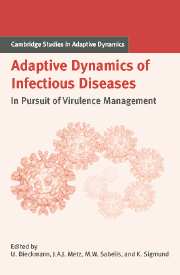Book contents
- Frontmatter
- Contents
- Contributing Authors
- List of Boxes
- Notational Standards
- 1 Introduction
- A Setting the Stage
- B Host Population Structure
- C Within-Host Interactions
- D Pathogen–Host Coevolution
- Introduction to Part D
- 13 Coevolution of Virus and Host Cell-death Signals
- 14 Biogeographical Perspectives on Arms Races
- 15 Major Histocompatibility Complex: Polymorphism from Coevolution
- 16 Virulence Management and Disease Resistance in Diploid Hosts
- 17 Coevolution in Gene-for-gene Systems
- 18 Implications of Sexual Selection for Virulence Management
- 19 Molecular Phylogenies and Virulence Evolution
- E Multilevel Selection
- F Vaccines and Drugs
- G Perspectives for Virulence Management
- References
- Index
- International Institute for Applied Systems Analysis
18 - Implications of Sexual Selection for Virulence Management
Published online by Cambridge University Press: 15 January 2010
- Frontmatter
- Contents
- Contributing Authors
- List of Boxes
- Notational Standards
- 1 Introduction
- A Setting the Stage
- B Host Population Structure
- C Within-Host Interactions
- D Pathogen–Host Coevolution
- Introduction to Part D
- 13 Coevolution of Virus and Host Cell-death Signals
- 14 Biogeographical Perspectives on Arms Races
- 15 Major Histocompatibility Complex: Polymorphism from Coevolution
- 16 Virulence Management and Disease Resistance in Diploid Hosts
- 17 Coevolution in Gene-for-gene Systems
- 18 Implications of Sexual Selection for Virulence Management
- 19 Molecular Phylogenies and Virulence Evolution
- E Multilevel Selection
- F Vaccines and Drugs
- G Perspectives for Virulence Management
- References
- Index
- International Institute for Applied Systems Analysis
Summary
Introduction: Sex and Coevolution
In contrast to asexual reproduction, sex involves a number of quite obvious dis-advantages (e.g., Williams 1975; Maynard Smith 1978; Stearns 1987; Michod and Levin 1987). The major disadvantage has been termed the “cost of meiosis” (Williams 1975): a female that reproduces sexually is only 50% related to her offspring, while an asexual female transmits 100% of her genes to each of her daughters. Hence, gene transmission is about twice as efficient in asexuals as in sexuals. The other disadvantages of sex are, for example, cellular mechanical costs, genetic damage through recombination, exposure to risks, mate choice, mate competition, etc. (see review in Lloyd 1980; Lewis 1987). Therefore, if asexuals had a survival probability comparable to sexuals, a mutation causing a female to produce only asexual daughters would, when introduced into a sexually reproducing population, rapidly increase in frequency and outcompete sexuals in numbers within a few generations (Williams 1975; Maynard Smith 1978). Why does this not happen? What are the advantages of sex, or what are the disadvantages of asexual reproduction?
One serious disadvantage of asexual clones is that they are likely to die out after some hundred or thousand generations because of a fatal mechanism called “Muller's ratchet” (Muller 1932). Roughly summarized,'s ratchet predicts that slightly deleterious mutations are accumulated in asexuals from generation to generation until the genome does not code for a viable organism any longer, and the population becomes extinct (e.g., Andersson and Hughes 1996).
- Type
- Chapter
- Information
- Adaptive Dynamics of Infectious DiseasesIn Pursuit of Virulence Management, pp. 248 - 261Publisher: Cambridge University PressPrint publication year: 2002



